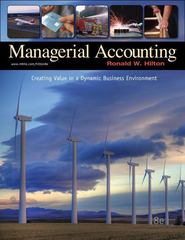A taxpayer can invest $10,000 in a taxable 10-year bond that yields an annual pre-tax return of 6 percent or buy land (a capital asset) for $10,000 that is expected to increase at an annual pre-tax rate of 4 percent. The taxpayer expects to hold the bond and the land for 10 years and expects to pay capital gains taxes of 20 percent when the land is sold. The taxpayer's marginal tax rate on ordinary income is expected to be 25 percent throughout the 10-year period. Which alternative is better in regards to which will cause the lowest tax liability/ the lowest amount of tax that will have to be paid? I have attached an document with the question on it I need number 2 and 3 answered 
ACCT 612 TAX RESEARCH PROBLEMS 2 INSTRUCTIONS For this assignment, you will be submitting an Excel worksheet with solutions (and corresponding work) for the problems detailed below. These problems will be due by 11:59 p.m. (ET) on Sunday of Module/Week 7. The purpose of this assignment is for you to apply tax planning principles to relevant scenarios. These problems should be submitted in an Excel worksheet, with each problem on a separate tab. Please label the tabs accordingly. You must show your work for each problem. Correct solutions without corresponding work will not be accepted. The Excel document should be labeled as follows: lastname_problems2.xls. As this is not a formal writing assignment, APA format is not required. Furthermore, there is no need to submit a title page or research page. Just include your full name at the top of first sheet. Problems: 1. Julia currently is considering the purchase of some land to be held as an investment. She and the seller have agreed on a contract under which Julia would pay $1,000 per month for 60 months, or $60,000 total. The seller, not in the real estate business, acquired the land several years ago by paying $10,000 in cash. Two alternative interpretations of this transaction are (1) a price of $51,726 with 6 percent interest and (2) a price of $39,380 with 18 percent interest. Which interpretation would you expect each party to prefer? Why? 2. Assume that a taxpayer can choose when he is to receive $10,000 of fully taxable income. If the taxpayer receives the income at the end of Year 1, he will receive exactly $10,000. If he delays receipt of the income until the end of Year 2, the amount will grow to $11,000. If the taxpayer takes the money at the end of Year 1, he can invest the proceeds and earn a pre- tax return of 10 percent over the next year. a. If the taxpayer faces a marginal tax rate of 31 percent in both Year 1 and Year 2, when should he elect to receive the income? b. At what pre- tax rate of return, will the taxpayer be indifferent to taking the money in Year 1 and Year 2? c. If the taxpayer's marginal tax rate increases to 35 percent in Year 2, when should he elect to receive the income? d. What would the tax rate need to be in Year 2 to make the taxpayer indifferent? ACCT 612 3. A taxpayer can invest $10,000 in a taxable 10- year bond that yields an annual pre- tax return of 6 percent or buy land (a capital asset) for $10,000 that is expected to increase at an annual pre- tax rate of 4 percent. The taxpayer expects to hold the bond and the land for 10 years and expects to pay capital gains taxes of 20 percent when the land is sold. The taxpayer's marginal tax rate on ordinary income is expected to be 25 percent throughout the 10- year period. 4. Greg Jones lives in New York City and has the opportunity to rent his condominium during the 2010 Olympic Games. He has two offers one to rent for 10 days at $500 per day and the other to rent for 16 days at $400 per day. Rental expenses will be negligible. What is your advice to Greg? 5. Paris Corporation holds a $100,000 unrealized net capital gain and a capital loss carryforward that will expire in the current year. Should Paris accelerate the recognition of this gain from next year to this year, assuming a net capital loss carryforward in each of the following amounts? Paris is subject to a 14 percent cost of capital. Its marginal tax rate is 40 percent. a. $40,000 b. $10,000 c. Repeat parts a and b, but assume that Paris is subject to a 6 percent cost of capital







